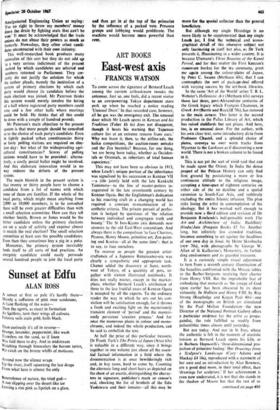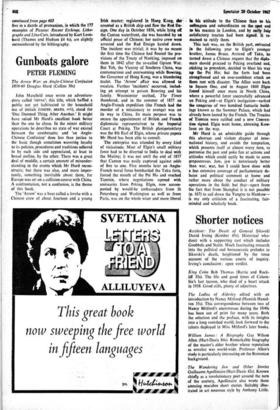East-west axis
ART BOOKS FRANCIS WATSON
To come across the signature of Bernard Leach among the current artbookware tweaks the antennae. Just so, one feels, did a recent visitor
to an overpowering Tokyo department store perk up when he reached a notice reading
'Unusual Door.' In that recorded case, however, all he got was the emergency exit. The unusual door which Mr Leach opens in Kenzan and his Tradition (Faber £6 6s) does not disappoint,
though it bears his warning that 'Japanese
culture lies at an extreme remove from ours.' Why not leave it, then, to the airline-ads, the haiku competitions, the auction-room netsuke and the Zen beatniks? Because, for one thing. 'we are being born today, whether as Occiden- tals or Orientals, as inheritors of total human experience.'
This may not have been so obvious in 1913, when Leach's unique portion of the inheritance was signalised by his succession as Kenzan VU —a title jointly held with the late Kenkiohi Tomimoto—to the line of master-potters in- augurated in the late seventeenth century by Kenzan Ogata. But the Englishman's dedication to his exacting craft in a changing world has required a constant re-examination of its aesthetic criteria. The private pursuit of perfec- tion is hedged by questions of 'the relation between individual and congregate truth and beauty.' The St Ives-Kyoto axis demands new answers to the old East-West conundrum. And always there is the compulsion 'to face Chartres, Picasso, Henry Moore, primitive art, Zen paint- ing and Koetsu—all at the same time': that is to say, to face ourselves.
To recover as people the greatest artist- craftsmen of a Japanese Renaissance-era was clearly a sympathetic and appropriate task. Chance added the discovery at Sano, north- west of Tokyo, of a quantity of pots, to- gether with sixteen illustrated notebooks. It dOes not really matter, except in the market- place, whether Bernard Leach's attribution of these to the last fruitful years of Kenzan Ogata is accepted by all the experts. To the ordinary reader the way in which he sets out his con- viction will be satisfaction enough, for it throws a fresh and exciting light on the mysteriously transient element of 'period' and the mysteri- ously persistent 'creative process.' And for once the numerous plates in colour and mono- chrome, and indeed the whole production, can be said to embellish the text.
At half the price of this particular treasure, Dr Frank Turk's The Prints of Japan (Arco 63s) is valuable in a differeht way, since it brings together in one Volume just about all the essen- tial factual information in a field where the dooumentation is at once bewilderingly rich and, in key cases, hard to come by. Counting the alternate long and short hairs as depicted on the chest of an ascetic, distinguishing the charac- ters in signature, publisher's mark or censor's seal, checking the list of brothels of the Edo Yoshiwara and their inmates—all this may be more for the special collector than the general beneficiary.
But- although my single Hiroshige is no more likely to be supplemented than my single Leach jar. I had the technical and icono- graphical detail of this obsessive subject not only fascinating in itself but also, as Dr Turk presents it, illuminating in a wider context. It is because Utamaro's Three Beauties of the Kanel Period, and for that matter the First ICenzan's stoneware bucket for the tea ceremony, greet me again among the colour-plates of Japan. by Peter C. Swann (Methuen 63s), that I can contemplate the sort of package-deal offered with varying success by the art-book libraries.
In the same 'Art of the World' series T. B. L. Webster's Hellenistic Art (Methuen 63s) surveys - those last three, post-Alexandrine centuries of
the Greek legacy which Francois Chamoux, in Greek Art (Barrie and Rockliff 70s), has restored to the main stream. This latter is the second production in the Pallas Library of Art, which has raised standards but not prices. And here, too, is an unusual door. For the author, with his ,own clear text, some introductory dicta from Professor Chastel, and a splendid choice of plates, conveys us over worn tracks from Mycenae to the Laokoon as if discovering a new world. There is not a broken column to be found in it.'
This is not yet the sort of vivid raid that can be made upon the Orient. In India the dense project of the Pelican' History can only find firm ground by postulating a more or less continuous attitude to the religious image, accenting a time-span of eighteen centuries on either side of the AD dateline and a spatial extension to South-East Asia, and ruthlessly excluding the entire Islamic infusion. The plan risks losing the artist in contemplation of his ideology. But it has worked well enough to proiide now a third edition and revision of Dr Benjamin Rowlands's indispensable work The Art and Architecture • of India: Buddhist! Hindu! Jain (Penguin Books £5 5s). Another long, but infinitely less crowded tradition, becomes something to set against the headlines of our own day in Sinai, by Heinz Skrobucha (our) 70s), with photographs by George W. Allan of St Katharine's Monastery, its forbid- ding environment and its guarded treasures.
It is a curiously simple visual adjustment to turn from a seventh century illumination of the Israelites confronted with the Mosaic tables to the Barber-Surgeons receiving their charter from Henry VIII. But the improbable feat of embodying that monarch as 'the ymage of God upon earthe' has been obscured by its sheer virtuosity. In Holbein and Henry VIII, by Roy Strong (Routledge and Kegan Paul 40s)—one of the monographs on British art stimulated by the Paul Mellon Foundation—the new Director of the National Portrait Gallery offers a particular evidence for the artist as propa- gandist, the role fulfilled so readily from palaeolithic times almost until yesterday.
But not today. And not in St Ives, where the authentic is felt in the moment of atavistic tension as Bernard Leach opens his kiln, or in Barbara Hepworth's 'three-dimensional pro- jeotion of primitive feeling.' Her Drawings from a Sculptor's Landscape (Cory • Adams and Mackay f4 10s), reproduced with a statement of
her own and an introduction by Alan Bowness, are a good deal more, in their total effect, than 'drawings for sculpture.' If her achievement is even now underrated, it is not that she stands in the shadow of Moore but that the rest of us
continued on page 066 continued from page 463
live in a dazzle of proteanism, in which the 177 examples of Picasso: Recent Etchings, Litho- graphs and Lino-Cuts, introduced by Kurt Leon- hard (Thames and Hudson f4 4s), are slightly outnumbered by the bibliography.



































 Previous page
Previous page